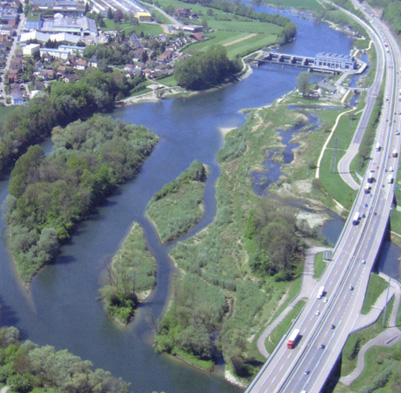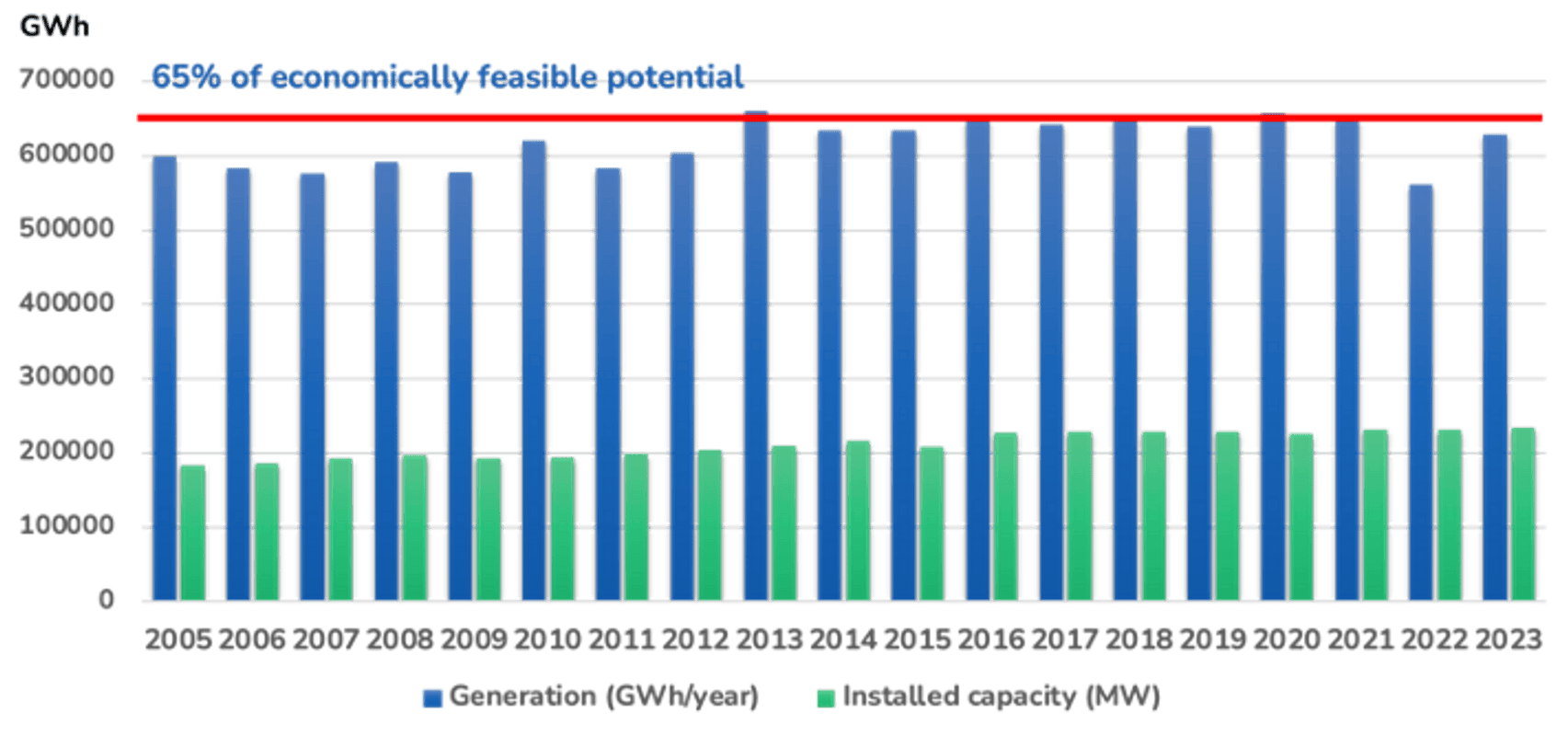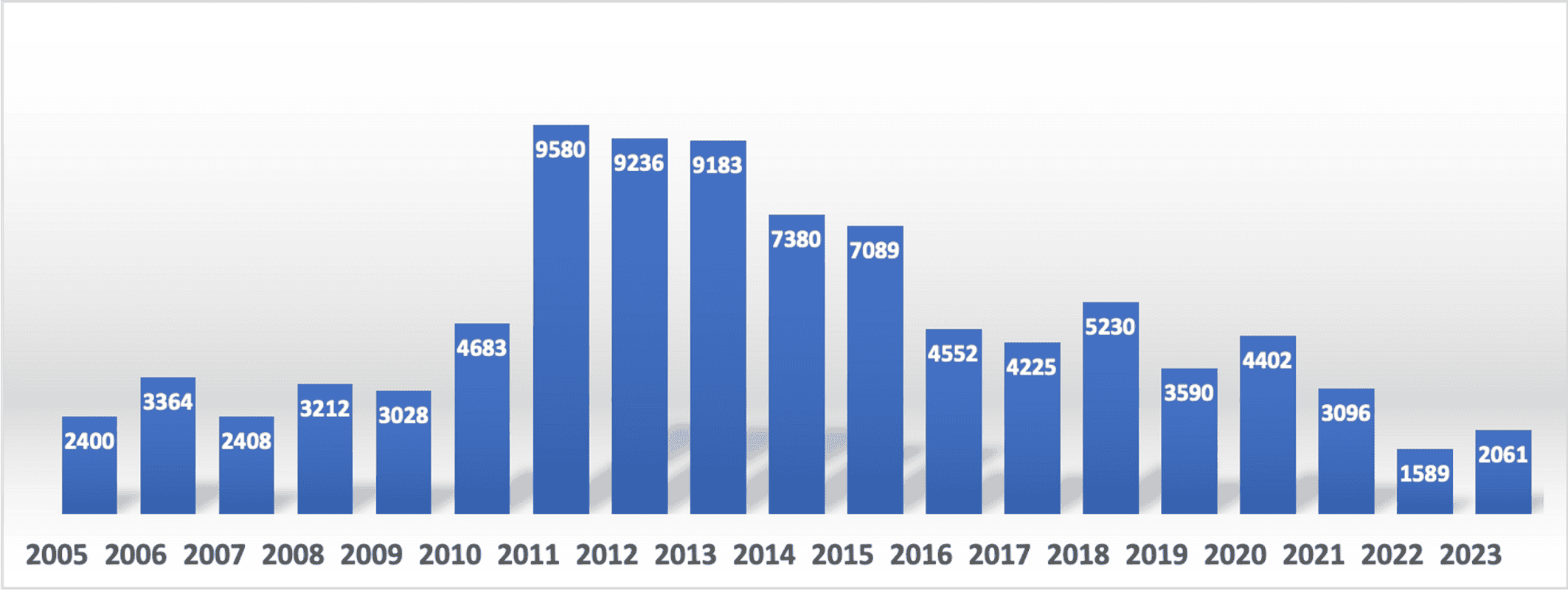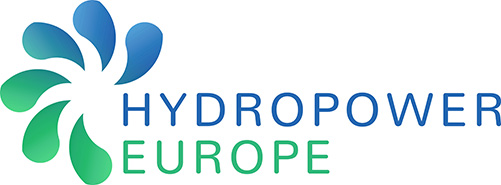UNIFYING THE VOICES OF HYDROPOWER
About Hydropower in Europe
Hydropower has a long history in Europe and in the first half of the last century contributed significantly to industrial development and welfare in most of the countries of Europe. Today, almost 650 TWh are generated in an average hydrological year, which equates to about 65% of the economically feasible hydropower potential within Europe including Turkey (Figure 1). Since a few years, the yearly production of hydropower stabilizes near 650 TWh and the total installed capacity near 230 GW. It should be noted, however, that the yearly hydropower production is also influenced by the hydrological situation each year as for example can be seen by the very dry year 2022.
Types of Hydropower Plants
In general hydropower plants, can be characterised according the criteria arrangement, gross head, possibility of storage and types of turbines as shown in Figure 3.

Ruppoldingen run-of-river power plant on Aar River in Switzerland with by-pass river for fish migration

Schematic presentation of a storage hydropower scheme with an underground powerhouse
Advantages of Hydropower
Hydropower in Europe, and indeed worldwide, has many advantages such as:
- Renewable energy without direct emission of CO2, excellent energy gain or pay back factor
- Excellent efficiency, production can be easy adapted to the demand (flexible peak energy)
- In-country independent energy creating jobs and financial resources in remote areas (taxes and concession fees)
- Strong contribution to flood and drought protection with potential for recreational and tourism activities
- Facilitating navigation on the large rivers in Europe
Challenges of Hydropower in Europe
This low and decreasing investment level between 2016 and 2022 can be attributed to the fact that electricity prices on the European spot market since a decade were very low due to the following reasons:
- Production capacity in Europe was too high (especially via conventional thermal generators using coal)
- The cost of CO2 certificates was very low
- The market was distorted due to the high subsidies provided for renewable energy sources such as solar and wind
Thus, under such market conditions hydropower generation was strongly penalized. However, the energy crisis since 2022 reveals the important and vital role of hydropower – storage and pumped-storage - to help ensure a safe supply of electricity in the coming winters in Europe. Due to the energy crisis, the attractiveness of the extension and upgrading of existing hydropower plants, with the purpose of making them more flexible through the refurbishment of equipment and increasing storage where possible, together with the construction of new pumped-storage power plants, has increased again strongly in countries with high storage potential. This is underlined by an increase of the construction activity above 2000 MW in 2023. Furthermore a kind of renaissance of hydropower can be seen in many countries. In 2024 between 9000 MW to 12’000 MW of new installed capacity were under planning revealing that a significant amount of untapped hydropower potential still exists in Europe.
However, in view of environmental and socio-economical constraints, the partial use of this remaining potential is extremely challenging and can be reached only through innovative and sustainable
solutions for new hydropower plants.
Future Role of Hydropower in Europe as a Catalyst for the safe Energy Transition
Hydropower plays an important role today and will become even more important in the coming decades, since hydropower can be a catalyst and enabler for a safe energy transition in Europe.
The ambitious plan for energy transition in Europe seeks to achieve a low-carbon climate-resilient future in a safe and cost-effective way, serving as a worldwide example. The key role of electricity will be strongly reinforced in this energy transition. In many European countries, the phase out of nuclear and coal generation has started with a transition to new renewable sources comprising mainly of solar and wind for electricity generation. However, solar and wind are variable energy sources and difficult to align with demand. Hydropower already supports integration of wind and solar energy into the supply grid through flexibility in generation as well as its potential for storage capacity. These services will be in much greater demand in order to achieve the safe energy transition in Europe, and worldwide.
Hydropower, with its untapped potential, has all the characteristics to serve as an excellent catalyst for a successful energy transition. However, this will require a more flexible, efficient, environmentally and socially acceptable approach to increasing hydropower production to complement wind and solar energy production. In particular through the vision:
- Increasing hydropower production through the implementation of new environmentally friendly, multipurpose hydropower schemes and by using the hidden potential in existing infrastructure.
- Increasing the flexibility of generation from existing hydropower plants by adaptation and optimization of infrastructure and equipment combined with innovative solutions for the mitigation of environmental impacts.
- Increasing storage by the heightening of existing dams and the construction of new reservoirs, which have to ensure not only flexible energy supply, but which also support food and water supply and thus contribute to the Water-Energy-Food NEXUS and achievement of the Sustainable Development Goals of the United Nations.
- Strengthening the contribution of flexibility from pumped-storage power plants by developing and building innovative arrangements in combination with existing water infrastructure.
Climate change will be an important issue for hydropower development in Europe. The effect of climate change will not only change the availability of water resources in time but will also change the behaviour of the catchment areas through increased sediment yield and more frequent natural hazards, thus endangering hydropower production in the future. It is recognized that the reservoirs associated with hydropower plants will have to contribute more and more towards the mitigation of climate change effects.
Mission of the ETIP HYDROPOWER project
The ETIP HYDROPOWER project runs from 2022-2025 and aims to:
- represent a consolidated and strong network of representatives from industry, academia, research centres, civil society and sectorial associations of the hydropower sector
- enhance and disseminate the Research and Innovation Agenda (RIA) and the Strategic Industry Roadmap (SIR) taking into consideration the future needs of the sector and the R&I targets and the emerging policy priorities
- align and coordinate the industry RIA and SIR strategies to provide consensus-based strategic advice to the European Commission and the SET Plan covering analysis of market opportunities and research and development funding needs, biodiversity protection and ecological continuity
- deepen the understanding of innovation barriers and the exploitation of research results in line with the latest EU climate and energy related policies
The ETIP Hydropower aims to be a recognised interlocutor for the European Commission, Member States and Associated Countries about the hydropower's sector specific R&I needs. ETIP HYDROPOWER foresees working relationships with the relevant national/regional/EU-level platforms to ensure synergies between EU, national and regional activities.
The HYDROPOWER EUROPE project
Under the HYDROPOWER EUROPE project (from 2018 to 2022), we developed the Hydropower Research and Innovation Agenda (RIA) and the Strategic Industry Roadmap (SIR). For more information on HYDROPOWER EUROPE visit the website

Figure 1: Evolution of yearly production and installed capacity of hydropower in Europe since 2005 (according Hydropower & Dams World Atlas 2024).

Figure 2: Generation and extension potential of hydropower in countries in the European region (according to Hydropower & Dams World Atlas 2021).The countries having developed less than 50% of their economical feasible potential (assuming market conditions have demand for it) are highlighted. The share of hydro in the electricity generation is indicated for the countries with a share more than 25%.

Figure 3: Characterization of hydropower plants

Figure 4: Installed capacity in MW under construction since 2006 (according to Hydropower & Dams World Atlas 2024 without Turkey).

